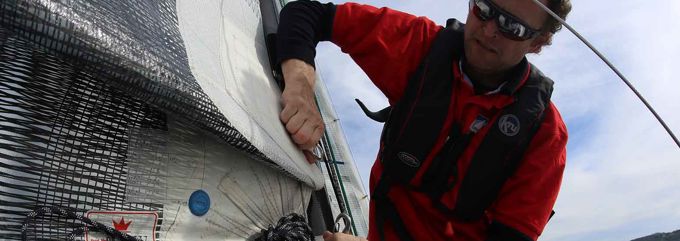
How to conventionally reef a mainsail
Andreas Hanakamp from Elvstrøm Sails in Wiener Neustadt, Austria knows what he talking about. On his CV you will find two Olympic Games, Volvo Ocean Race, Fastnet, Middle Sea Race, Transat Jacques Vabre plus numerous regattas. And then he conducts a lot of training sessions.
How do I reef a sail?
- Support the boom: The helmsman holds the yacht on an upwind angle when the slack is taken out of the topping lift of the boom. In case you have a kicker, there is no need for a topping lift. You only want to prevent the boom crashing on the deck or hooking up with your lifelines.
- Ease the mainsheet: Easing the main initiates the reefing procedure. The sail will lie stable on the deflected air stream coming off the headsail and the pressure in the boat decreases. Helmspeople need to watch out that the balance of the boat changes – you want to hold a steady course. Important: Ease the sheet before you ease the halyard.
- Ease the halyard: I prepare the halyard on boats I frequently sail on for easy reefing by having the amount of halyard I need for the next reef not tailed but loose, plus a bit of rope that goes on the winch. To prevent too much wear on rope and clutches take the load on a winch before opening the clutch. With a jammer for the mainsheet you have to do it anyway as you cant open the jammer under load. One crewmember starts pulling down the luff of the sail at the mast. On larger yachts you might want to rig a line pulling down on the luff but – beware of forcing the main down as you might damage the luff, sliders or cars.
- Stop at the right position: A marking on the halyard shows how far you have to ease the halyard for the crew to be able to hook the reef point at the gooseneck. This mark facilitates precise and quick reefing. Without the mark you either drop the main too far our not enough. Both an aggravation for the crew at the mast, slow and unnecessary additional work. Once on the mark, the halyard can immediately be prepared for hoisting (turns on the winch, handle in).
- Hook the main: The crew hooks the reefpoint at the luff of the sail and gives a clear sign to the pit for the halyard to go up.
- Hoist the main: I recommend having another mark to indicate how far the main has to come up. Of course the marks should have different colours.
- Next the reefing lines: The load of the new clew has to be divided into a vertical and a horizontal component – the reef line should provide both. The line exits the boom, the goes thru the grommet at the leach of the sail and then down to the boom. Fix the tail of the reef line around the boom if you have a loose foot or tie it to a fitting at the boom if the foot is fixed to the boom. How to tie the reef line around the boom: lead the line around and tie a bowline around the vertical part of the reef line. When loaded the line will tighten around the boom. There might be variations on some boats but the principle remains the same. A detail to prevent damage to the sail: On the picture you see, that the sail falls down freely to leeward and is not crushed as the reefing line runs on the windward side of the sail. Of course that is not so easy to achieve – if you change tack before reefing it doesn’t work so well with the sail to windward. Sometimes you might have a chance to re-run the reefing line.
- Tighten the reefing line: The foot of the sail has to be completely flat – you only achieve that with the reefing line at the right position. If you are not happy with luff- or foot tension repeat the relevant steps.
Expert's hints:
Before you consider reefing, flatten your sails. Flat large sails are aerodynamically more efficient than smaller and deeper ones.
Badly reefed and trimmed sails are not safe. When the breeze is on – sail well! The standard course is on the wind. Helmspeople should hold a steady course and focus on helming – even if the balance of the boat changes throughout the manoeuvre.
To head into the wind for reefing is wrong an dangerous. Practise reefing on other wind angles as well. If the sail is tight against to rig, be patient, don't force it down. Slight changes in wind angle will help.







